Although the colour green isn’t for everyone, emeralds are in a class by themselves. Also, The colour of the stone is unrivalled, making it one of the most valuable gemstones on the market. With its lush blueish-green tones, the emerald has consistently outperformed other green gems such as peridot and tourmaline.
But what is an emerald without a bit of fanciful lore and history? Regardless of how you feel about the colour of an emerald, these quick and to-the-point emerald facts will help pique your interest in this rare specimen.
What is Emerald Stone?
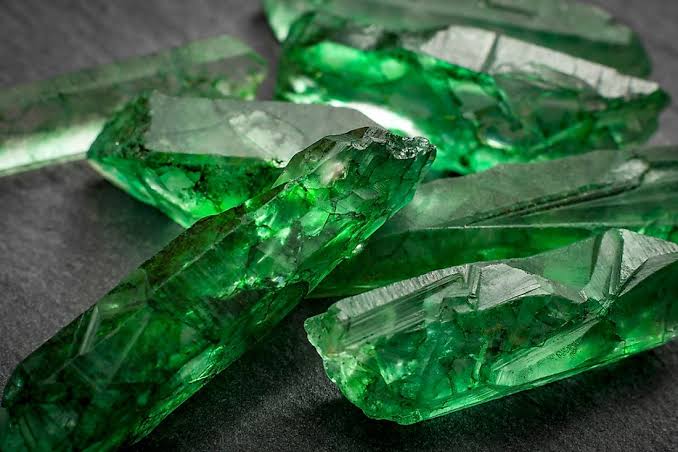
Apart from diamonds, emeralds are the most valuable and scarce gemstones. They’re regarded as royalty’s and romance’s crown jewels. Emeralds are known for their deep green colour and unique natural inclusions.
Emerald is also known as natural beryl in the scientific community. Trace elements of chromium and vanadium are responsible for the green colour. Emeralds are much softer than many other precious gems.
On the Mohs scale, they’re a 7.5. (diamonds are 10). Because emeralds can break or chip when subjected to high pressure or heat, setting them in jewellery necessitates a high level of skill.
Emeralds naturally vary in colour depth and purity, and all emeralds contain numerous inclusions that form during the natural growth process. The colour of an emerald is more important than its clarity. The higher the value, the purer and more vivid the deep green colour.
Different Shapes
Emeralds are cut in a variety of shapes, the most popular of which are the round cut and the octagon “emerald” cut. Round emeralds can also enhance the emerald’s refractive quality, making it sparkle more.
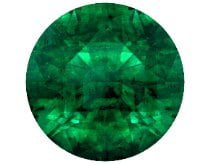
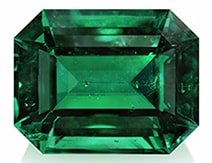
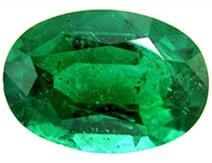
Color, however, reigns supreme over all other gemstones. Cushion cut emeralds have become increasingly popular, following closely behind round emeralds. Cushion cut emeralds are typically available in 6mm+ (approx. 1.0ct+) sizes. Oval, Princess, Pear, and Marquise are some of the other common shapes.
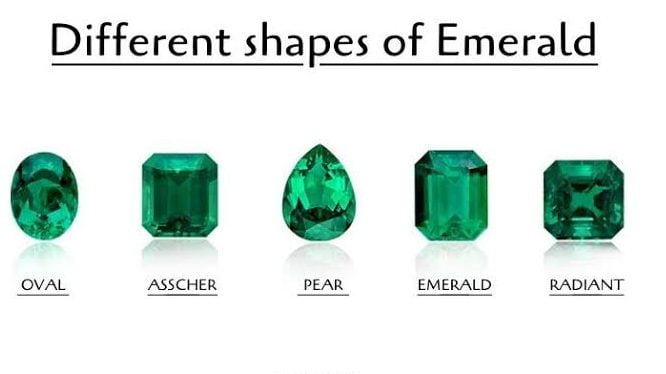
Round and emerald cut emeralds are significantly more expensive than most fancy shapes. Emeralds in the oval and pear cut come in a wide range of sizes. Princess emeralds, also known as square emeralds, are usually smaller than 5mm in size. This is due to squandering and the demand and supply for those shapes.
Furthermore, for engagement rings, emeralds have surpassed diamonds as a popular choice. They can be as costly as diamonds in some cases, so it’s a personal choice.
Emerald History
- About 2.97 billion years ago, the oldest emeralds were discovered.
- Around 1500 BC, Egypt produced the first emeralds.
- Emerald was one of Cleopatra’s favourite stones, and she was well-known for her love of it.
- In the 16th century, the Spanish discovered emeralds in South America. The Incas had used them for a long time before they were discovered.
- The Spanish exchanged emeralds for precious metals across Europe and Asia, allowing the emerald trade to expand worldwide.
- Emeralds were discovered in North America for the first time in 1997 in the Yukon Territory, but large emerald deposits in the United States and further north are extremely rare.
- Synthetic sapphire and ruby were created in 1907, but it wasn’t until 1935 that American chemist Carroll Chatham successfully grew his first 1-carat Chatham emerald. The Smithsonian Institute now has this stone on display.
Symbolism & Stories about Emeralds
- Putting an emerald under your tongue, according to legend, will allow you to see into the future.
- Emeralds were thought to improve intuition and protect against memory loss.
- Do you want to know if what your partner is saying is true? Emerald was thought to function as a kind of truth potion, assisting in the determination of whether the lover’s vows were true or false.
- The emerald’s soft, calming colour allowed early lapidaries to rest their eyes after a long period of concentration. Emerald is still believed to relax and relieve eye strain today.
Value Of Emerald
- On a per-carat basis, high-grade emeralds can be more valuable than diamonds.
- The majority of emeralds contain some sort of inclusion or flaw, and flawless emeralds are extremely rare. Dealers prefer to refer to emerald inclusions as an internal jardin rather than using the term imperfection (“garden” in French).
- The four factors that determine an emerald’s value are colour, clarity, cut, and carat weight. Color is the most crucial of the four. Green or blueish-green with even saturation and no colour zoning is the best colour.
- High-quality emeralds are transparent and not too dark or light in colour. Some gemologists may not even consider green beryl that is too light in colour to be an emerald.
- A 10x loupe is used by a gemologist to grade the clarity of a diamond. The clarity of an emerald is frequently determined by looking at it with the naked eye.
The Duke of Devonshire Emerald, measuring 1,383.93 carats, is one of the biggest uncut emeralds.
| Emerald | Origin | Location | Size | |
| 1. | Chipembele | Zambia, 2021 | ISDE, Israel | 7,525 carats |
| 2. | Carolina Emperor | United States, 2009 | North Carolina Museum of Natural Sciences, Raleigh | 310 carats uncut, 64.8 carats cut |
| 3. | Bahia Emerald | Brazil, 2001 | Los Angeles County Sheriff’s Department | 180,000 carats, crystals in host rock |
| 4. | Duke of Devonshire Emerald | Colombia, before 1831 | Natural History Museum, London | 1,383.93 carats uncut |
| 5. | Chalk Emerald | Colombia | National Museum of Natural History, Washington | 38.40 carats cut, then recut to 37.82 carats |
| 6. | Emerald of Saint Louis | Austria | National Museum of Natural History, Paris | 51.60 carats cut |
| 7. | Rockefeller Emerald | Colombia | Private collection | 18.04 carats Octagonal step-cut |
| 8. | Mogul Mughal Emerald | Colombia, 1107 A.H. (1695–1696 AD) | Museum of Islamic Art, Doha, Qatar | 217.80 carats cut |
| 9. | Mim Emerald | Colombia, 2014 | Mim Museum, Beirut | 1,390 carats uncut |
Some Notable Emeralds
Emerald Size
Emeralds are cut and measured in millimetres instead of carats, from length to width. For emerald size, carat weight is a better approximation. Even though the length and width of the shape are the same, the emerald’s colour may be highlighted by cutting it deeper or shallower, dramatically affecting the carat weight.
The price of emeralds rises exponentially as their size grows. The emeralds that are round or octagon in shape will appear to be the most prominent. Cushions and princess cuts will appear to be the tiniest of all.

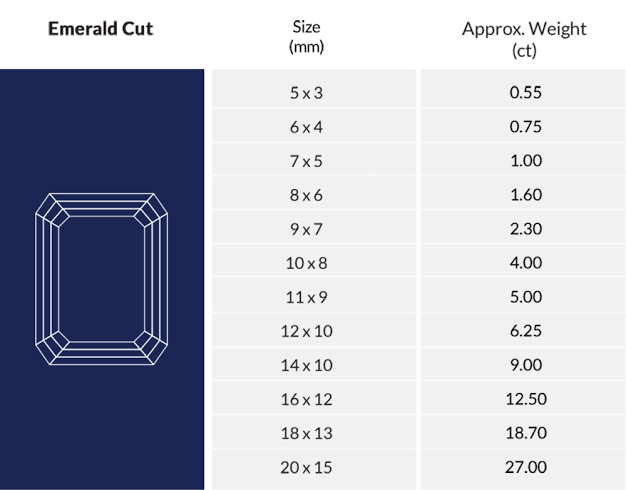
More size and weight is distributed in the depth of the Gemstone with squarer shapes. A manufacturer may reduce the size of a diamond to remove inclusions. However, this is rarely the case with emeralds because inclusions are found throughout natural emerald.
Color of Emerald

The colour of an emerald is the single most important factor in determining its value. The colour hue, tone, and saturation of the emerald are examined and graded. These three factors will determine whether the emerald is AAA quality (the best) or C quality (the worst) (lowest). Color is graded AAA, AA, A, B, and C, despite the fact that colour evaluation is subjective and there is no industry-wide standardisation.

Colors ranging from bluish green to pure green, with vibrant colour saturation and a tone that isn’t too dark, are the most desirable emeralds. The most valuable emeralds are transparent. There is no colour zoning visible to the naked eye, and their colour is evenly distributed. If the colour is too yellowish or blue, the stone isn’t an emerald, but a different type of beryl, and its value drops accordingly.
Nothing else in nature compares to the intensity of green found in the finest emeralds. The trace elements that give emerald its colour are chromium, vanadium, and iron. the presence or absence of each of these elements, as well as their relative amounts indicates The exact colour of an emerald crystal.
The mine location is sometimes links to the appearance of emeralds. Colombian emeralds are a little warmer, more intense shade of pure green. The colour of Zambian emeralds is cooler and more bluish green. Regardless of these theories, the truth is that the appearance of emeralds varies depending on the source.
Clarity Of the Stone
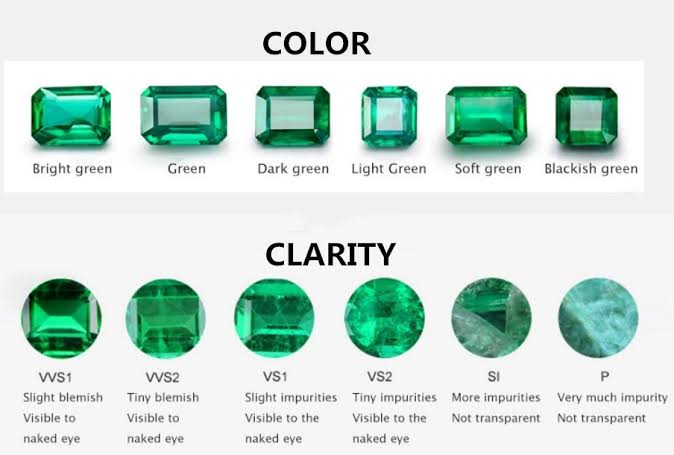
Emeralds are among the most popular gems. Inclusions, which are small flaws in emeralds that can be seen without magnification, can be found in all of them. Clouds, needles, crystals, feathers, pinpoints, and cavities are all included in the emerald inclusions. During the emerald’s growth process, inclusions occur naturally.
In the case of emeralds, there is no standard grading system. In the AAA rating scale, they simply blend with colour. Because inclusions can be found in any emerald, it’s best not to be concerned about their visibility in higher grades. In determining the emerald quality, colour is the most important factor.
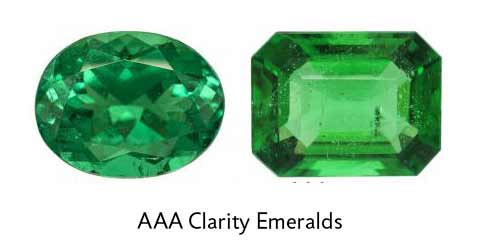
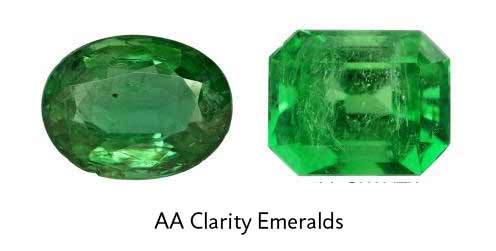


However, colour reduction will occur in very large, heavily included emeralds, as the inclusions will wash out the colour. The emerald’s quality grade will be affected if this is the case.
The clarity of an emerald, like its colour, is assessed without magnification when it is held up to the light. The important thing is to look at the clarity as a whole rather than focusing on a single inclusion. Fissures or small fractures inside the emerald that appear as wavy or random whitish lines are the most common inclusions.
Sourcing
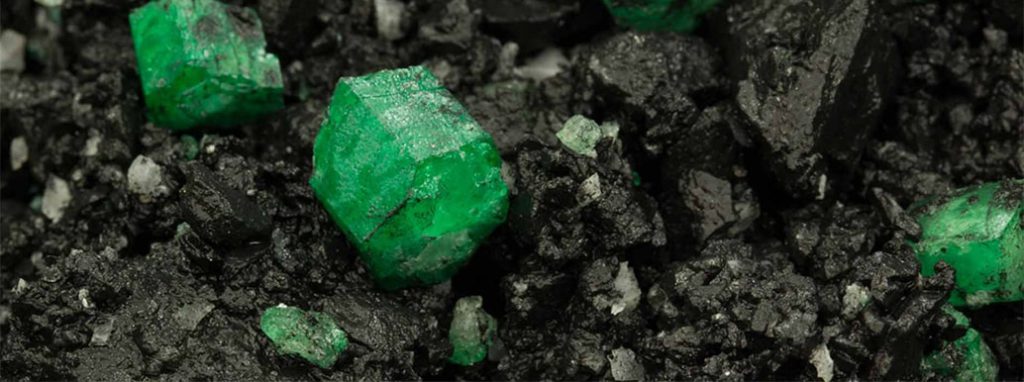
The process of emerald mining is fascinating. Emeralds are usually found attached to other rock formations rather than as a single rough gemstone. Because technology and machinery can increase heavy pressure on rock formations and break apart heavily included emeralds, emerald mining is often done by hand.
Emeralds are typically mined in pits, and rock is blasted into larger chunks. Those pieces may or may not contain emerald (natural beryl), which is removed and eventually used in manufacturing.
Emeralds are a prevalent substitute to diamonds in engagement rings. They are a intricate, rich, and royal gemstone in addition to being one of a kind. Emeralds are more rare than diamonds, so they aren’t a reliable source of conflict fuel. This is beneficial because it ensures that your gemstone is conflict-free and that your love remains pure.
Certification
Because emeralds are a valuable gemstone, it’s important to know how to grade them. Emerald certification will determine whether your emerald is natural or synthetic. In most cases, emeralds under 6.5mm in size do not require certification if they are purchased from a reputable jeweller.
The value of certification diminishes as there is no quality grading scale for emeralds. Furthermore, the origin and nature of the emerald can be verified through certification, which may be important to someone.
Fake or non-natural emeralds will never appear to be the right shade of green, and they are frequently over-treated to bring out colour. In addition, a lack of inclusions can make an emerald appear less appealing. Because of the natural nature of inclusion, emeralds have a distinct identity and exciting appeal.
Carat Weight
Embellished emeralds are available in a variety of shapes and sizes. Emeralds weighing hundreds of carats can be found in museums and private collections. Small emeralds weighing fractions of a carat are on the other end of the spectrum.
The smallest sizes range from 1 to 5 mm in diameter, with weights ranging from 0.02 to 0.50 carat, with 1 to 5 carat stones being prominent as centre stones. One can find emeralds weighing more than 20 carats in prestigious jewellery. Thus, as the size of the emerald grows larger, the price rises dramatically.
Cut

When making cutting decisions, the cutter must consider the rough’s colour depth, durability, and inclusions. Weight loss occurs as a result of mistakes, lowering the value of a potentially valuable gem. Emerald crystals are difficult to cut due to four characteristics.
- To begin with, almost every emerald has significant fractures (sometimes called fissures in the trade). A cutter must plan the cut so that the fractures have the least impact on the finished stone.
- Secondly, emeralds are more brittle than gems like corundum, which is partly due to those inherent fractures. As a result, this exposes them to damage during cutting, polishing, and setting, as well as careless daily wear.
- Third, because colour is so important in determining an emerald’s value, the cut should emphasise hue, tone, and saturation. By adjusting the proportions and number of facets of an emerald, the cutter can change its colour.
- Fourth, many emerald crystals’ bluish green to yellowish green dichroism encourages the cutter to align the table perpendicular to the crystal’s length. As a result, the bluish green that so many emerald collectors prize is more visible in the cut gem.
Science Behind The Stone
During handling and setting, emeralds are brittle and easily fractured. They are rated as having a hardness of 9. They are not as hard as diamonds, but they are extremely durable. These are easily scratched, but the scratches can be wiped away.
Emeralds come in a variety of colours, from light to dark green. The presence of chromium oxide and vanadium determines the shade of green. The emerald’s green colour is said to have “entrapped humankind” throughout history.
It is the birthstone of May because of its colour, which represents new life and the promise of spring. The emerald rich grass green is also known as limpid, velvety grass green, or deep transparent grass green with a lustre.
Instead of deflecting attention away from the richness of colour, a square cut to the emerald actually emphasises it by leading the eye into it. Some people actually prefer the less-than-perfect shades of green.
Emerald Buying Guide
Purchasing an emerald is difficult because you cannot rely on a certificate to determine its quality. Thankfully, our eyes have the ability to recognise the beauty of gemstones.. You can almost instantly tell if an emerald is of good quality or not. However, two emeralds of the same quality can appear to be different in colour or clarity. The beholder is the judge of beauty!
Stick to a Budget
Because of their rarity, emeralds are the most expensive gemstone. It’s critical to stick to a budget and enlist the help of a jeweller in determining the best size and quality combination.
Choose a Shape
Emeralds come in a variety of shapes, the most popular of which are round and octagon. Other shapes, such as pear and oval, are also good at showcasing the size and colour of emeralds. Consider round emeralds if you want your emerald to sparkle more. Consider a fancy shape like emerald cut or oval if you’re looking for a more pure, deep colour.
Quality Selection
All emeralds have inclusions. Technically, quality is a combination of colour and clarity, but with emeralds, the pure colour is more important. Color also hides or masks clarity inclusions, making it extremely important. Because choosing between emeralds can be difficult, it’s sometimes best to enlist the help of a reputable jeweller. Simply specify your emerald criteria to your jeweller, whether online or in person, and let them choose.
Choosing Size
When it comes to emeralds, we usually think of size first, but quality is just as important. Once you’ve decided on an emerald style and colour, size up or down to fit your budget. Thus, don’t be afraid to stretch your budget as far as it will allow. Emeralds are rare and expensive, so unlike semi-precious gemstones, they will rarely be too large for jewellery.
Natural vs. Synthetic
Natural stone gives emeralds their rich, royal appeal. Emeralds have an emotional connection to nature because they are so rare. The inclusions give the emeralds a personal touch. Synthetic colouring is also visible in nonnatural emeralds. They give off a colour that your eye might not recognise.
Going natural is something we recommend. Jewelry is a significant financial and personal investment. The value of emeralds rises as they become more scarce. You will not have disappointments if you choose natural emerald.
Treated Emeralds
Emeralds, like other gemstones, are frequently treated to improve their colour and lustre. Because emeralds have more inclusions than other gemstones, they frequently require treatments to ensure their purity. These treatments are designed to heal and protect natural fractures and fissures that occur during the growth process.
They can also change the colour of the emerald to a more vibrant pure green. More than 99 percent of emeralds are treated. Untreated emeralds are extremely rare and can cost anywhere between 10 and 20 times as much as treated emeralds. Oiling, dyeing, irradiating, and lasering are the most common emerald treatments.
Emeralds are soaked in hot cedar oil during the oil treatment. Cedar oil has the same refractive index rating as emeralds, making it an excellent choice. The hot oil soaks into the cracks, fractures, and fissures in the concrete. The emerald cools inside, and the cedar oil solidifies.
As a result, there has been a significant reduction in clarity inclusions, as well as an overall improvement in the emerald’s health and structure. Additionally, by reducing the clarity inclusions, it will have more luster/brilliance which improves the colour.
Final Thoughts
For over 6,000 years, the emerald has piqued the interest of many cultures. It is so valuable that a fine emerald can be worth two to three times as much as a diamond, carat for carat. Emeralds are thought to contain the energy required to give your work its creative form. A high-quality emerald was once thought to change colour to warn the wearer of impending danger. One can also use it to express feelings of love, devotion, and adoration.
Keep coming back to our blog for more such articles!
FAQ Section
What is emerald stone good for?
The gemstone emerald is known as the ‘Stone of Prosperity.’ It is a symbol of growth and vitality. Wearing a high-quality Panna gemstone can help you earn more money and advance in your career. Thus, people who work in banking, finance, stock market trading, or bookkeeping, for example, should wear Panna, according to astrologers.
How much does 1 emerald cost?
Emeralds can cost anywhere from $1 to $100,000 per carat. Any gem can be of varying quality, ranging from opaque and only suitable for carving to transparent and well-colored, making auction houses smile.
How can I tell if my emerald is real?
The colour of the gemstone is frequently used to determine its genuineness. Examine the colour of your gem by holding it up to the light. Genuine emeralds have a pure green or blue-green colour. As a result, if the stone you’re holding has yellow or brown undertones, it’s almost certainly fake.
Share with your friends






